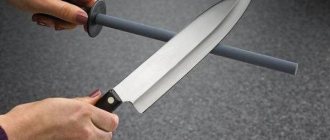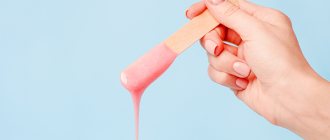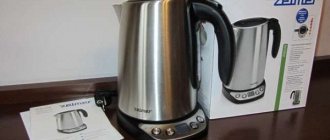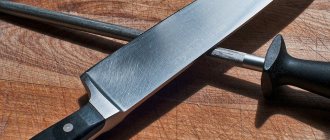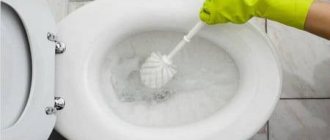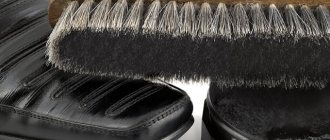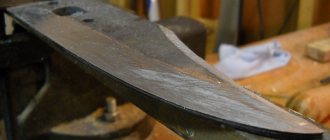Sharpening of knives can be carried out using a whetstone, sharpening machines, mechanical and electric sharpeners. There are devices that are used not for sharpening the edge of a blade, but for straightening them - for example, with the help of musat you can “in no time” restore the cutting ability of a knife.
If you need sharpening of professional knives, surgical instruments, or hunting “arsenal”, then you should turn to professionals or use special devices. The price of sharpening one knife in workshops can range from 100-350 rubles.
Leave the knives alone!
For some this will be a revelation, but there are knives whose blades cannot be sharpened , otherwise they will be damaged forever! These include:
- Knives with a serrated blade , or serrated knives. Outwardly they resemble a saw. But they differ from carpentry tools in that the shape of their sharpening is asymmetrical relative to the blade. Serrators can be located along the entire length or on some segment (half-serrators). You can sharpen them, but this requires special equipment and skills that the home master does not possess. Conventional double-sided regrinding destroys them.
- Knives with branded coating . For example, the company Zwilling JA Henckels produces TwinStar Plus knives. A unique composition is applied to their cutting part, thanks to which wear resistance increases many times over. And during the turning process, the protective coating is erased.
How to sharpen a serrated knife
If you have serrated knives in your kitchen, then you need to know that these utensils cannot be sharpened with regular sharpeners. To make this version of the cutting surface sharp, you need to do the following:
- Prepare a special tool for serrated blades, namely a cone-shaped sharpening rod, preferably made of ceramic.
- Determine the side on which the beveled teeth are located and sharpen this part of the blade.
- Place the sharpening device at an angle to the beveled part of the blade.
- Sharpen each depression with several movements, moving the blade in the direction “away from you.”
- Remove the formed burrs using sandpaper or the same rod, but do not press on the surface, but act gently.
- Sharpen the smooth side of the blade with a suitable tool.
Remember not to use a rod to trim the serrated surfaces on the side of the blade where they are missing, otherwise you will ruin the knife.
Edit or sharpen?
Before you get started, it's worth finding out what kind of maintenance your cutting edge needs.
At home, you have two ways to make a knife sharp:
- If the knife is slightly dull, edit it .
- If the blade has not been serviced for a long time or is damaged, sharpen it - remove excess metal from the sides of the cutting edge.
A worn knife with severe damage to the blade - chips, chips, bends - needs professional repair. But it is quite difficult to do it at home, and you will probably have to contact a workshop.
The best manufacturers of sharpening machines
In the budget segment, for simple sharpening tasks you can find good offers from domestic manufacturers. These are machines costing up to 3-4 thousand rubles. from brands such as “Vikhr”, “Kraton”, “Caliber”, etc.
The middle and most popular segment is represented by models with a price tag of approximately 5 to 10 thousand from Bosch, Metabo and Makita. According to reviews, one of the best knife sharpening machines in this group is the Bosch GBG 60-20 model. It has balanced characteristics and decent German workmanship.
Private craftsmen and industrial workers will be interested in professional models. This is a narrow, but technologically developing class of sharpening machines from companies such as Inforce and Proma in the BKL line.
Stocking up on tools
To sharpen a knife yourself, you will need the following tools:
- Musat (steel) is used for straightening . It can be made of solid steel, ceramics, or have diamond coating. In shape it resembles a file with an oval or round cross-section of the working part. Metal dusters are magnetized and attract metal dust. Ceramics are lighter, but more fragile. Musates are not used if the blade hardness is less than 50 units. HRC or more than 60 units. H.R.C. In the first case, they remove too much material, and in the second, their use will not bring results. Such files are used for knives with the correct geometry.
- Sharpening stones are the main tool for sharpening . They come in different degrees of grain. To restore the correct angle and shape of the cutting edge, the coarsest stones are used, the thinnest ones are used for straightening and finishing. The sharpening stone should be no shorter than the blade, but better – one and a half times longer. In extreme cases, when there is no stone at hand, sandpaper is used.
- Special straightening devices are devices made of several metal or ceramic disks that are partially nested one inside the other. They are convenient because they do not require professional skills and are completely safe. They can quickly remove burrs on a knife, which makes it sharper, but at the same time dulls just as quickly.
How to check the grinding wheel?
Whatever wheel is used in the work, it must be carefully checked before performing the operation. The audit must begin with a visual inspection. The item should not have the slightest crack or even chip.
Next, a check is performed on the machine. For this procedure, it is better to use a professional knife sharpening machine, which provides more effective safety features and customization options. On it, in particular, it will be possible to check the abrasive wheel for runout. This defect is expressed in vibrations, when, upon external observation, the outer edge of the disk moves away from the center to the sides. If such a flaw occurs, then the abrasive will need to be corrected with a special diamond device.
Ways to sharpen a knife
Musat
First edit:
- Musat is rested with his end on the table.
- The blade is passed along it with medium pressure, maintaining an angle of 20–25° to the surface.
Second edit:
- Musat is kept suspended.
- Use a knife to “attack” the file at an angle of 45°.
To sharpen it, it is enough to make 4–5 movements in both directions . To remove metal particles from the surface of the musat, wipe it with a damp cloth.
On the stone
- The sharpening stone is immersed in water for a while or simply wetted. Place it on a thin cloth or a sheet of paper so as not to scratch the countertop.
- The knife is taken by the handle with one hand, and the other is placed on the blade.
- Place it towards the stone at an angle of 20–25 degrees or greater (depending on the purpose of the knife).
- Smoothly, evenly, with medium pressure, move the cutting edge forward along a semicircular path, as if cutting off an invisible film from the surface of the stone. The direction of movement must be perpendicular to the cutting edge. At the end of the bar they reach the tip of the knife. The movement is repeated for each side.
- The blade is processed until a uniform burr appears along its entire length. You cannot sharpen only those parts where there is no burr - this will lead to premature wear.
- After sharpening, grinding is carried out, for which stone is also used, but with minimal grain size. Actions and movements - as described above.
- If the knife becomes dirty, wash it with water.
- It takes 5–7 minutes to work on one side.
- To simplify the task and not “fill up” the cutting edge, you can paint over it with a marker. After several cycles, evaluate the condition of the painted part: it should wear off evenly.
Sharpener
At home, you can sharpen a knife using a machine . It is especially convenient if you use many knives with different angles in the kitchen. To restore sharpness, just turn on the device, insert the knife into the slot, and move it back and forth several times.
Professional sharpening of knives: how and what is better
While elementary, simple sharpening devices can be used for kitchen knives, professional sharpening of office knives, bread knives and surgical instruments requires a more serious approach. Most often, special devices are used for this manipulation, which are selected individually for each type of knife.
Hunter knives
In the field, hunting knives are best sharpened with mechanical pocket sharpeners, which can have different shapes and sizes, but are always of high quality materials. It is enough to run the knife several times along a special cut - and “at the exit” the edge of the blade will become sharp again.
Manufacturers of professional sharpening tools also offer hunters round or flat rods on a plastic/wooden handle - they are used for emergency knife sharpening. Round sharpeners are made of ceramic, flat ones have a diamond surface.
Among stationary tools, it is better to give preference to a case of sharpeners for hunting knives, which has a special clamp, numbered sharpening angles, and several stones with varying degrees of abrasiveness. Additionally, oil is included, which allows you to bring the hunting knife to perfection in terms of sharpness.
Scalpel
Surgical instruments, including scalpels, are sharpened using whetstones, emery and carborundum wheels. The sharpening angle is 15 degrees, and it must be strictly maintained throughout the entire process.
It is important to follow two rules:
- make movements during sharpening only with the blade forward;
- Both sides of the blade are processed on the sharpening device simultaneously.
This means you don't have to go through 50 strokes to sharpen one side of the blade and then the other - the sides have to be constantly changing. Scalpels are made of high-quality steel, so no burrs (roughness) are formed on their surface. It is necessary to periodically monitor the process and check the surgical instrument for sharpness.
Watch the video about sharpening a medical instrument:
Serving knives
Serving knives cannot be sharpened because they are made of a special metal - an oxidized or complex composition (alloy), which often contains precious metals. This type of knives is designed for cutting ready-made dishes, and they are a priori distinguished by their softness and pliability.
Boning knife
Boning knives can be sharpened with any equipment because they are made of durable steel and can withstand aggressive external factors. Since such knives are used for a long time, in addition to the main sharpening, periodic editing of the blade will be required. This can be done with a mechanical sharpener with wheels, musat, and a small whetstone.
Stationery knife
Stationery knives are made of thin metal, so you don’t need to use any special tools to sharpen them. But it’s worth taking a closer look at the structure and design of the blade – they have notches at a certain distance from each other. And if you take the edge of the knife with pliers and simply break it along the notch, then “sharpening” will take place instantly - the edge will become sharp again.
Thus, it will be possible to restore the cutting ability of a stationery knife 5 times for one replaceable blade.
You can break off a piece of dull metal using the back cover, it is located on the handle . To do this, remove the lid, insert a blade into the slot up to the line and turn it to the side. It will break off along this line.
Round knives
Round knives are used in the kitchen (for example, for cutting pizza, dough), in sewing workshops (for cutting pieces of fabric). It is almost impossible to sharpen them at home, because this process requires a professional tool such as a sharpening machine for hairdressing scissors.
In general, craftsmen avoid working with this type of knives and recommend purchasing new cutting tools as the blade becomes dull.
Flat knives
Flat knives are those used on woodworking machines and include chisels and plane blades. They can be sharpened with a whetstone, following the instructions:
- The blade is mounted on a whetstone (grindstone, whetstone) at an angle of 30-40 degrees.
- The chamfer is pressed against the whetstone with one hand (fingers), and the other holds the blade in the adjusted position.
- Move the edge of the blade along the block until a burr forms on the surface.
- Replace the whetstone with the same device with a fine abrasive surface and remove the burr using the usual sharpening movements.
It must be remembered that flat knives are sharpened only on one side . You can check the level of sharpness obtained on a wooden block - you need to remove the shavings from it.
Bread
A bread (serrated) knife is sharpened with a cone-shaped rod - it is placed in the space between the teeth. It is better if this sharpening tool is made of ceramic. Before starting the process, you need to determine the beveled side of the cloves - this is what needs to be processed.
The rod is inserted between the teeth at such an angle that it fits snugly against the edge, the movements are performed away from you and slowly, only 2-5 “pulls” are required to obtain the desired result. All nicks are processed in this way.
At the end of the work, you need to run your fingers along the back of the knife - small scale and burrs should be clearly felt on it, which indicate that the sharpening was carried out correctly. They are removed with fine abrasive sandpaper.
Watch the video on how to sharpen a bread knife:
Peeler
You don’t sharpen a peeler yourself, because given the low cost of this kitchen tool, it’s easier to buy it again to replace an already dull one. If the vegetable peeler is expensive, then you should take it to a professional, although he will most likely refuse such a service - the cutting parts in this device are too inconveniently located.
Japanese knives
Japanese knives are sharpened on water stones; you need several such sharpening tools with different levels of abrasiveness - from the smallest to the coarse. Before starting the process, the stones must be soaked in water (it covers them completely) for 3-5 minutes; the instructions for them indicate that this manipulation is carried out until air bubbles stop coming to the surface.
Japanese knives are sharpened in the usual way, but without even the slightest effort. The concave sides of kitchen tools are not sharpened; they are only passed over the stone a couple of times - this is necessary to remove burrs.
Make do with improvised means
It happens that you don’t have a special device at hand, but you still need to sharpen the knife, for example, on a hike or in the country. Here are some tips to help you get out of this situation .
- Any stone can be sharpened, including brick or concrete. The movements are the same as with traditional manual processing. The stone needs to be slightly moistened.
- By flipping a ceramic plate over, you can create a sharpening tool because ceramic is harder than metal. True, the process will take longer.
- You can use the bottom of a ceramic mug in the same way.
- If you don’t have ceramic dishes at home, take a glass glass and sharpen it on the edges.
- Surprisingly, you can sharpen a knife even with cardboard, although you will have to put in more effort.
- If you happen to have sandpaper on hand, feel free to use it.
- The option of sharpening a knife on a knife works well.
- And the last method, it is more suitable for finishing the sharpness of the knife. This method can be used to polish the knife after any sharpening. Use a genuine leather .
How to sharpen a knife to razor sharpness
Almost any blade can be given a razor sharpness. To achieve this, use one of the methods below:
- Treat the surface with GOI paste and a piece of genuine leather, after removing nicks using a fine-grained stone. Remember that you need to carry out finishing work, moving from the handle to the tip, without changing direction, and keep the blade at an angle.
- Grind down the edge until the serrations are fine, and then grind the other side of the blade in the same way. This will add some spice, but not for long.
- Use ceramics, for example, turn a plate upside down and sharpen the device on the untreated areas on the bottom that are not covered with glaze.
When working, be careful not to get injured in the form of a cut or damage the blade.
How to sharpen ceramic knives
Ceramic knives are becoming increasingly popular , which is understandable. According to manufacturers, their blades are second in hardness only to two materials - corundum and diamond. Opinions are divided regarding the possibility of sharpening them. Some experts claim that they are not dull, so there is no need and cannot be sharpened. Others argue that ceramics also wear out.
Read also: Spray gun attachment for vacuum cleaner
Typically, ceramic knives are provided with a guarantee, and they are sharpened completely free of charge in branded workshops. But this can also be done at home, for which special grinders or sharpeners are used.
You can also use diamond-coated wheels or electrocorundum (80 µm for roughing and 40 µm for finishing). The blade is processed at low engine speeds, with the lowest wheel runout, 2-3 cycles for each side. The tool is moved traditionally from the handle to the tip. It is important to pay attention to the fact that the cutting edge in ceramic models has a slightly convex shape.
Every craftsman should know that the number of sharpenings of a ceramic knife is limited .
Features of professional sharpening machines
Such equipment has several technical and operational differences from household analogues. But it’s worth emphasizing right away that the cost of this machine can be 2-3 times higher than models for home use.
So, we are talking about more productive, functional and precise units that can confidently adjust the shape of an edge made of tool and high-speed steel. As a rule, professional electric knife sharpeners have a durable metal base, a balanced rotor, almost always the ability to install two wheels, and a powerful three-phase motor.
In terms of functionality, it is worth emphasizing the possibility of adjusting the reach, point-by-point adjustment to the dimensions of the tool being processed, and automatic wetting of the working equipment, which protects it from overheating.
How to check the sharpness of a knife?
Under no circumstances should you check the sharpness of the cutting surface with your finger. If you move carelessly, a cut forms on the skin, into which metal particles get trapped. Such a wound takes a long time to heal. The most famous way to check is to cut the paper by weight , holding the sheet by the corner. The knife should pass easily, without tears.
The sharp blade does not produce glare along the length. Their presence indicates that there are still dull areas on the blade and you will have to work a little more.
It is important to carry out maintenance on time . If this is not done, the blade quickly becomes unusable and you have to buy a new knife, which is not cheap. If you are unable to cope with the task yourself or have doubts about your own abilities, it is better to entrust this matter to a specialist.
We also found an excellent video on the topic of sharpening knives, it perfectly complements our article:
It is simply impossible to describe all the nuances of how to properly sharpen knives in one article, but this is not always necessary. Especially if an ordinary kitchen knife needs sharpening or you are just a beginner who needs to start somewhere.
- In fact, sharpening a kitchen knife to a sharp point at home can be done easily and quickly. But the difficulty is that this must be done in such a way that the sharpness of the blade is preserved for a long time, and at the same time too much steel is not removed from the blade.
In this material we will try to simply and clearly tell you how to properly sharpen a knife with a whetstone. After all, this method is not only basic and accessible to everyone, but also the most effective. In addition to step-by-step instructions for sharpening and finishing, here you will find a selection of training videos and an overview of alternative methods - from sharpening systems to the bottom of a ceramic plate.
Grinding
During processing, a sharpened knife develops microprotrusions and fractures—burrs. These defects are eliminated at the final stage for kitchen knives - grinding.
The grinding function is usually already built into the machines. It is done manually using a fine-grained abrasive. More professional products are polished at the end of processing.
When polishing yourself, you can use stretched leather - a special paste is applied to it. You should move the blade along the skin with movements toward you (towards the handle).
If sharpened correctly, the product will be razor sharp and will last a long time. Universal sharpeners allow you to bring not only knives to this state, but also, for example, scissors.
A little about choosing stones
Sharpening stones come in the following types:
- Ceramic;
- Diamond;
- Natural;
- Japanese water stones.
If you wish, once you gain experience, you can buy some solid and expensive diamond stones or Japanese water stones. However, it is better to start with ordinary ceramic bars (such as “Boats”), which are sold in every household goods store. They are wear-resistant, durable and affordable. The only drawback is their uneven abrasion.
Here are tips to help you find the right assistant:
- What size should the block be? Ideally, it is 1.5-2 times longer or at least not shorter than the knife blade. The width and shape of the bar is not important.
- When purchasing a block, make sure it is flat and free of chips.
- To start, you can buy one medium-hard all-purpose whetstone. But if you wish, buy one block with two sides of different grain sizes or two stones with a large and half the grain size. In the future, a couple more stones may be added to your collection.
- It's best to try to get a couple of Soviet-made donkeys, say, at flea markets or from your grandfather. Bars marked “Made in the USSR” have uniform-sized grains and high-quality binding material.
To bring your knife to razor sharpness, in addition to sharpening stones, you can also buy GOI abrasive paste, which we will also talk about working with.
Abrasive wheel selection options
This consumable material for a processing machine is available in a wide range. The sharpening wheel specifically for a knife should be designed for working with steel and the possibility of finishing correction.
The shape of the profile is fundamentally important for working with sharpening. In this case, equipment with a straight profile is used, which is optimal for straightening the blade.
The grit size will determine what type of finish a particular abrasive wheel can provide. For a sharpening machine used to correct a knife blade, almost all types of fractions can be used. Usually there are three ranges - from 400 microns, from 1000 microns and from 5000 microns. Accordingly, coarse, medium and fine sharpening is provided. Sometimes you can limit yourself to just finishing touches if the blade requires only minor editing.
The type of abrasive itself is equally important. Although knives are not overly demanding tools in terms of machining and dressing, today it is better to give preference to the more durable and efficient alumina blades. This material is hard and resistant to damage.
7-step instructions for sharpening and finishing a kitchen knife
So, in sharpening a knife, one goal is to remove enough metal from the blade so that the cutting edge becomes sharp again. You need to start work with a coarse-grained abrasive and finish with a fine-grained one.
It is important to remember the following principles of sharpening knives:
- The most important thing is to choose the optimal sharpening angle and maintain it along the entire cutting edge while sliding along the block.
- Movements should be smooth, without pressure.
- All bars must be moistened with water, or better yet, with a soap solution: before sharpening (so that the blade glides better and metal dust does not clog the pores), during the process (to remove the resulting suspension) and at the end, to clean the bar.
And one more important tip - the first time it’s better to practice on a knife that you don’t mind ruining. Especially if your main knife is too good and expensive. Well, let's start practicing.
Step 1. Rinse the stone with water, and then run over it, say, with a sponge with a drop of dishwashing liquid.
Step 2. Next, sit down at the table and place the stone on a wooden board, for example, a cutting board. You can place a towel under the stone. For some it is more convenient to place the block perpendicular to themselves, and for others at an angle of approximately 45 degrees. Over time, you will understand how it is more convenient for you to work.
Step 3. Now you need to decide on the sharpening angle and fix the position of the knife. What should the angle be? The general principle is that the smaller it is, the sharper the blade, and the larger it is, the longer the blade retains its sharpness.
- Regular kitchen knives are sharpened to an angle of 40-45 degrees. If you are sharpening a fillet knife (designed for cutting thin pieces of fish, poultry and meat), then you should sharpen it sharper - at an angle of 30-40 degrees. The selected value must be divided by 2, and then we will get the angle that should be between the blade and the surface of the block. That is, to sharpen a blade at 45 degrees, you need to sharpen each side at 22.5 degrees to the sharpening surface.
A simple technique shown in the photo below will help you fix the knife at an angle of 22.5 degrees.
- Remember, you should try to stick to the chosen angle throughout the entire work.
Step 4. Place the knife across the block so that the upper edge of the handle is above the lower edge of the stone. Holding the handle with one hand and the blade with the other, we begin to slide along the block away from ourselves along the trajectory shown in the picture below.
Watch a short and clear video:
- The point is that the cutting edge sliding along the stone should always be perpendicular to the direction of movement.
- At the bend of the blade, the knife handle needs to be slightly raised to maintain the selected angle.
- Remember also that you can’t put pressure on the blade, but you shouldn’t give it any slack either.
Thus, you need to pass the blade along the stone about 40-50 times, namely until a “burr” (burr, microsaw) appears along the entire length of the cutting edge. Its appearance will tell you that the excess metal has worn out and there is no point in grinding further. Then you need to turn the blade over and repeat the same steps. Clearly in the video:
- A burr is a small roughness that is difficult to see, but can be felt by carefully running your finger along the edge of the blade (but not along the edge, so as not to cut yourself).
Read also: Universal template 00316
During operation, a suspension will appear on the blade - metal dust, which must be periodically washed off with water.
Step 5. So, the burrs have appeared, now we proceed to finishing. To do this, we repeat the same manipulations on a stone with half the grain size. An alternative finishing method is using musat.
- Musat is a steel rod of oval or round cross-section with longitudinal notches. It is only suitable for editing and maintaining sharpness, but not for sharpening a knife. It is recommended to edit the knife with musat every time before and after work.
How to sharpen a kitchen knife with musat can be seen in the following video master class from the respected knifemaker Gennady Prokopenkov, who, by the way, specializes in making kitchen knives.
Step 6. If desired, you can bring your knife to a razor sharpness. To do this, take any leather or leather belt, treat it with GOI, Dialux or any other abrasive paste, and then do the same steps, but only in the direction from the cutting edge.
Step 7. Finally, we check the quality of sharpening. This is done very simply. It is enough to cut a tomato or cut paper. If you wanted to achieve razor sharpness, then you should try to shave the hair on your arm. The sharpest knives can even cut hair, as shown in the photo below, but in the kitchen such sharpness is not required for the most ordinary knife.
Knife sharpening
Sharpening is required for any of the knives, regardless of what material the tool is made of.
| Causes of dullness | Explanation |
| Natural friction on the material | Microscopic changes occur in the blade, when it is impossible to determine them visually, but the need to apply more pressing force when working with the knife is clearly felt |
| Contact of the blade with solid particles of material such as grains of sand | Macroscopic damage appears on the blade, because when confronted with such an “obstacle,” the edge of the knife can either move it away or move away by crushing it |
| Inappropriate use of a tool - digging the earth, unscrewing/twisting fasteners, etc. | The blade deteriorates very badly, it can change its shape and completely lose its cutting ability. |
With constant load on the blade, not only the knife becomes dull. If it is made of high-quality steel, then its edge simply crumbles, and the softer metal begins to curl and deform.
Sharpening angle
The ideal sharpening angle for knives is 20 degrees, but for different types of this tool it is worth using individual parameters:
- hunting, folding/pen-pocket - to obtain maximum sharpness of the edge, the process is carried out at an angle of 30-35 degrees, and if you need to get a blade that is resistant to subsequent dulling, then the angle changes to 40-45 degrees;
- ordinary kitchen ones (not professional ones) - sharpen at an angle of 25-30 degrees, if they are made in Japan - 10-20 degrees;
- tactical (combat) knives – sharpening should be carried out at an angle of 35-40 degrees;
- professional chef's knives, for boning meat and cutting it into thin fillets - at an angle of 25 degrees.
When choosing the desired option, it is worth remembering two nuances:
- if the sharpest possible knife is required at the output, then the sharpening angle should be small;
- if it is necessary to maintain the cutting capabilities of the tool for a long time, the angle is made larger.
When sharpening, you need to maintain the selected angle throughout the entire process, for which it is recommended to work with smooth movements and slightly lift the knife handle while processing the bend of the blade. Movements must be carried out at a constant right angle relative to the cutting edge of the blade.
What to sharpen
You can sharpen knives with a variety of devices; even housewives can handle some of them:
- whetstone (touchstone);
- mechanical or electric sharpener;
- Musat;
- "Lansky".
Mechanical sharpener Oselok Musat Lansky
Sharpening machines are a professional tool that only a master can operate . They operate at very high speeds and have an increased risk of injury.
Touchstone (sharpening stone)
Sharpening stones are available with different surfaces, depending on the number of abrasive particles located per square millimeter of their surface. It is understood that to sharpen a knife you will need at least two whetstones - with maximum abrasiveness at the first stage of the process and with minimum at the last, when the final grinding of an already sharp blade is carried out.
Russian-made sharpening stones do not have any markings, so you will have to purchase them only by visually assessing the degree of abrasiveness of the surface. Imported whetstones have clear markings, according to which the choice will always be unmistakable.
Touchstone with handle
Mechanical sharpener
The simplest device for obtaining a sharp blade is used to “sharpen” kitchen knives. It is enough to run the blade along a special notch 2-5 times and its edge will become sharper. You cannot expect high quality from this method of sharpening a knife, but it is quite suitable for daily use and for kitchen knives.
It is strictly forbidden to sharpen hunting, sports and professional chef's knives with such a sharpener.
Mechanical knife sharpener KitchenIQ 50265
Electric sharpener
High quality knife sharpening can be achieved using an electric “tool”. The advantage of using an electric sharpener is that you can independently set the angle to get a perfectly sharp blade, and this is a built-in feature in most modern models of this device.
This method is used both in home kitchens and in public catering. The cost of the device varies, but to get better results, you should not save.
Electric sharpener SITITEK Mistress 31M
Musat
Not intended specifically for sharpening a knife blade, used only to maintain its sharpness. Visually, musat resembles a file with a handle and is included in most sets of kitchen knives. If you just need to “straighten” the blade, then this tool is perfect, but if the edge of the blade is dull, then you will need to use other types of sharpening tools.
You can maintain the sharpness of a knife blade with musat for a long time, for which you only need to constantly and regularly use it.
Sharpening a knife with musat
Sharpener "Lansky"
The Lansky sharpener is a complicated design and is suitable for processing only small and medium-sized knives. Structurally, it consists of a rod, a removable whetstone (sharpening stone) and two corners that are connected to each other. The latter work as a vice and securely hold the knife in the “machine”, and also have graduations on their surface - this ensures the correct setting of the sharpening angle.
The Lansky sharpener always comes with several sharpening stones (stones) with different levels of abrasiveness.
Watch the video about the Lansky knife sharpener:
Sharpening and grinding machines
Professional sharpening machines are used only in industrial production conditions and are designed for maximum precision sharpening of rotating shafts. But there are also machines with an electric drive, abrasive wheels, and grinding discs - they can be used at home, but only an experienced craftsman is allowed to work on them.
If sharpening is carried out incorrectly on such machines, the knife blade will be unsuitable for further use, and the likelihood of injury to the “sharpener” increases. This happens against the background of very high rotation speeds of the abrasive wheel (grinding disc) and high temperatures due to friction of materials.
Alternative sharpening methods
If your kitchen knife is a simple and inexpensive “hard worker” and/or you just don’t want to delve into the “knife culture”, then we recommend using an electric sharpener, a roller knife or a sharpening system for sharpening at home. What are their pros and cons?
- An electric sharpener sharpens knives perfectly and quickly, but even the highest quality models remove too much material from the blades, thereby shortening their service life. Another disadvantage of an electric sharpener is that a good device costs more than $200.
- A roller knife is an inexpensive and easy-to-use option. With its help, you can quickly sharpen a kitchen knife, but, unfortunately, the sharpness of the blade will not last long and the knife will deteriorate over time. The most trusted tool among roller scissors is the one from Fiskaris (pictured). Do not confuse a roller blade with a V-shaped blade. The latter is an option for the most frugal.
- Sharpening systems are good because they allow you to more accurately set and maintain an angle. There are different types of such sharpeners - with blade fixation (manufacturers DMT and Lanski) and with fixation of the stones themselves at a certain angle (Spyderco Triangle Sharpmaker). Separately, we can highlight a sharpening system in which you can select the desired angle and control the position of the knife - this is the Edge Pro Apex Knife Sharpening System. Each system has its own pros and cons. For example, on sharpeners with a fixed blade it is inconvenient to sharpen wide chef knives, but on a triangle from Spyderco the knives are straightened rather than sharpened, and you can only choose an angle of 30 or 40 degrees. However, for kitchen knives these are the angles that are needed, and using a triangle is very simple. A detailed review and operating instructions for the Spyderco sharpener can be seen in the following video.
What are the disadvantages of Apex Edge Pro? Perhaps this is just a high price - $245. However, to sharpen kitchen knives, you can buy a Chinese copy of this sharpener (for example, on Aliexpress).
There is another clever way to sharpen a knife at home - using a rough mark on the bottom of a ceramic mug or plate. The principle of operation is still the same - maintaining the angle, smooth movements, maintaining the cutting edge (cutting edge) perpendicular to the direction.
All people who have experienced cutting food with a dull knife understand that kitchen work becomes a difficult and dangerous task. Because of this, the cooking speed decreases, but with a well-sharpened tool such problems will never arise.
The danger when cutting food is that a knife with a dull blade can spring back and cut your finger. It is for this reason that it is very important to maintain the blade in good condition by regularly sharpening your kitchen blade. This article is devoted to how to sharpen knives correctly.
Kitchen knife sharpening angle
The sharpening angle of a regular kitchen knife should be 25-30 degrees, and this parameter must be maintained throughout the entire process. If sharpening is carried out independently, then you can understand exactly how to hold the knife in relation to the whetstone as follows:
- you need to cut an even square out of paper;
- fold it in half diagonally - this will be an angle of 45 degrees;
- fold the sheet in half again - you get the desired parameter.
This piece of paper, folded several times, just needs to be leaned against a sharpening stone and the knife blade aligned along it. Periodically, you can stop the sharpening process and check again that the angle is set correctly.
For hunting knife
A hunting knife should be sharpened at an angle of 30-35 degrees . This parameter must be maintained with any method of returning cutting abilities. Since a feature of hunting knives is the large width/thickness of the blade, it is worth using semi-professional tools for sharpening them, for example, a Lansky sharpener will be convenient.
Sharpening rules
One of the most popular sharpening options is a whetstone. The accessory can be either fine-grained or coarse-grained. At home, the blade is processed until a burr is formed (a narrow strip of the blade), then a fine-grained stone is used and brought to perfection.
How to sharpen a knife at home using a whetstone:
- The blade should be at least 2 times shorter than the bar.
- The work is done on the table.
- During operation, the whetstone is periodically treated with water.
- Always before starting the process, the blade is constantly sealed with tape, especially if the tool is new. Otherwise, scratches will appear.
- To make an even sharpening, it is recommended to position the blade at a right angle in relation to the whetstone.
- Sharpening should be done along the entire length of the blade. They take a knife, put it against the block and begin to pass the blade, starting from the handle and ending with the tip. The movements are performed on oneself.
- The angle of the tool during sharpening work is kept at 25 degrees from the surface of the sharpening stone. This is necessary in order to create a hangnail. But you cannot change the angle of inclination in any part of the blade, otherwise the blade will turn out uneven.
- It is important that the edge blade does not jump off or get scratched when approaching the boundaries of the stone.
- Do not put excessive pressure on the tool. This back and forth movement is repeated many times. If you increase the pressure when sharpening, the work will not speed up, but a change in angle cannot be avoided.
After repeated repeated movements, the kitchen knife will be sharpened, but after this you should begin to grind the blade. This stage of work is intended for:
- perfect blade smoothness;
- imparting durability to sharpening by eliminating burrs.
For these purposes, the same sharpening stone is used, but with a finer grain.
Types of sharpening
There are several types of knife sharpening:
| Types of knife sharpening | Description | Example |
| Lenticular | The edge of the blade is sharpened, and the bend of the blade can also be processed. With such sharpening, blades are distinguished by a high level of cutting ability; they are able to “work” even on thick material, and, if necessary, serve as a chopping or piercing tool. Lens-shaped sharpening is carried out exclusively by hand, therefore it is used only in the production of professional knives - kitchen, hunting, tactical. | |
| Razor sharpening (flat) | It is carried out at a minimum degree (10-20) and is suitable for processing only surgical instruments, razor accessories, and blades for fine cutting. In everyday life, such sharpening is done for hunting knives for special purposes - for example, skinning knives, fishing knives. | |
| Wedge sharpening | It is rarely used, because after it the cutting ability of the tool increases, but the strength of its blade decreases. During the process, the side surfaces of the blade must be grinded and polished, but at home this is quite problematic. | |
| Pentagonal sharpening | It is widely used for kitchen and travel knives; even household devices for this process often perform just this type of knife sharpening. After it, the blade slightly loses its tactical abilities, but its service life does not decrease. | |
| Double-sided asymmetric sharpening | Combines enhancing the tactical and physical abilities of knives. The result will be ease of cutting even the hardest products, flawless chopping of material without any effort. This type of sharpening is often used in the manufacture of Japanese kitchen knives, which are of high quality. A special feature of knives with double-sided asymmetric sharpening is that the edge of the blade does not enter the cut on the product, but is constantly held on top. |
There are many ways to sharpen knives, they will differ depending on the tool used for this.
The technology of sharpening at home with a whetstone by hand
At home, sharpening can be done in the simplest way - with a whetstone by hand, step-by-step instructions for the process:
- The block is placed on the table in such a way that it does not slip or move. To do this, place a kitchen towel or any other textile napkin under the stone.
- Moisten the surface of the bar with water. There is no need to fill it, just spread a few drops and this will help not only to easily sharpen the knife, but also to completely clean the block of metal particles at the end of the work.
- Place the knife across the block and begin to move it away from you, imitating the movements when sharpening a pencil. In total, you need to perform about 50 movements on one side to achieve a slight roughness (burr).
- Turn the knife over and do the “procedure” for the other side of the blade, also moving along the block at least 50 times until a characteristic burr appears.
It is important to remember two nuances:
- as you sharpen, you need to maintain the angle of contact of the blade with the block;
- You need to continue the process until (changing sides of the blade) until the formed burr completely disappears.
Only after the last condition is met can you stop sharpening and proceed to grinding. To do this, you will need a stone/block with a finely abrasive surface; the movements are the same as before, but to achieve the desired result, it is enough to repeat them 20 times on each side.
How often should you sharpen?
It is believed that knives need to be sharpened as they become dull, but experts recommend this “event” be carried out at least once a week. In this case, it will be possible to maintain the cutting ability of the tool, and the sharpening itself will take place quickly and efficiently.
If we are talking about manual/mechanical sharpeners with wheels or musat, then they can be used at least every day - the knife will be sharp, but not for long. These devices are needed for straightening the knife, and not for fully sharpening it.
Types of knives
Throughout the history of mankind, a large number of types of blades have been invented, including some very specific ones. For each type, a manufacturing technology for a specific steel has been developed; the most popular material is considered to be 45-60 HRC. The angle of the knife during processing also depends on the choice of steel.
Important! The most popular types of knives are hunting and kitchen.
Kitchen
Not a single housewife can do without it, so such a tool is in every kitchen. It performs the functions of cutting bread, vegetables, meat and many other products, which is why it is important to know how to properly sharpen kitchen knives. But kitchen blades have many purposes, for example:
But many do not use highly specialized models, but work mainly with several types:
- Knife-saw . The blade is made of serrated teeth. This allows you to cut bread and rolls even into the smallest pieces. Then the product will not crumble. But sharpening a kitchen model with serrations is not easy to do.
- Chef knife . Used for cutting vegetable and meat products. Its length is 20 cm.
- Paring knife . Typically its length varies from 5 to 10 cm.
There are mainly 2 materials used for kitchen knives: ceramics and steel.
Important! The best models are made of stainless steel with a high percentage of carbon. Their blade grinds down more slowly, does not oxidize, and can be used to cut even the hardest products.
Read also: Nichrome or fechral which is better
The ceramic blade is quite fragile, but such knives can cut anything, while sharpening is less susceptible to loss of sharpness. You can also sharpen a ceramic blade at home, but you need a special diamond wheel.
For hunting
During a hunt, there are different situations, sometimes a firearm misfires, and at the most necessary moment, which is even life-threatening, only a well-sharpened hunting dagger can save you. For this reason, excessively increased requirements are placed on them:
- The blade should not only be beautiful, but also practical.
- A prerequisite is a wooden handle.
- When cutting up prey, problems may arise, so the guard should be kept to a minimum.
- When striking an animal with a knife, the metal may crack. Therefore, for hunting purposes, only those daggers that are made of Damascus steel are bought.
- According to the standard, daggers have a length from 10 cm to 17 cm. The width is at least 3 cm. The butt must be 4 mm thick. Steel strength is at least 58 HRC.
To easily remove the skin from a trophy, you should use those types whose butt is equipped with a hook.
Other types
But, besides daggers and kitchen knives, there are many options that are used in a specialized area:
- Combat models are intended for special services and the army.
- Touring knives are quite easy to sharpen and edit, since they are made from synthetics.
- For invisible carrying, folding options are used.
- The multi-tool option is a small universal tool that contains many other tools, for example: a corkscrew.
- A special category of special models is intended for gardening, divers, and surgeons, for example: scalpel and office type.
- Camp options are rarely used, mainly for clearing dense thickets by cutting. In appearance, the tool is similar to a machete, but the model is slightly smaller.
- Knives in the sporting direction are used only for throwing at the target.
- Table models are used to sort the table.
Important! Not long ago, models for survivalists began to be produced. The blade is similar to a multitool, but is equipped with more necessary elements, for example: a lighter and a compass.
Main types of knives
Before you start sharpening a knife, you need to find out what material it is made of. There are several types of knives:
- Carbon steel knives are the most affordable, made from an alloy of iron and carbon, easy to sharpen and remain sharp for a long time. Among the disadvantages, it can be noted that the knife blade oxidizes from interaction with food or an acidic environment, due to this, rust and stains appear on the knife, and food acquires a metallic taste. Over time, after plaque forms on the blade, oxidation stops.
- Low carbon stainless steel knives are made from an alloy of iron, chromium, carbon and in some cases nickel or molybdenum. Stainless steel knives are inferior in hardness to carbon steel, so they quickly become dull and require regular sharpening. The advantages include corrosion resistance.
- Knives made of high-carbon stainless steel are a higher class of knives, with a higher carbon content and additions of cobalt or vanadium. Due to the higher quality alloy, this type of knives does not require frequent sharpening and is not subject to corrosion.
- Damascus steel knives are mainly made as edged weapons, but there are also kitchen options. A Damascus steel knife is a multi-layer blade made from different high-quality alloys. The disadvantages include the high cost of knives.
- Ceramic knives have gained popularity because of their sharpness and ability not to become dull for a long time. But in addition to their advantages, ceramic knives have a significant disadvantage, which is their fragility when dropped from a height and poor resistance to fracture.
Methods for checking the blade tip
Blade sharpness is the most basic requirement for any type. The tool must be safe and reliable for a wide variety of jobs. There are several methods for checking whether a blade has been sharpened well.
On paper
Take a sharpened tool and an A4 paper sheet. The process is this: you should cut the paper, and if at the same time the blade begins to move to the side, then the sharpening is done at a low level, and if the cut is even, then the blade is quite sharp.
On a tomato
In addition to kitchen options, you can also test all types of blades. The meaning of the test is this: take a fresh tomato and cut a slice. If the blade moves to the side, it means that the sharpening was poorly done, but if it is smooth and without difficulty, then the work was done at the highest level.
Testing on hand hair
The knife is drawn against the direction of hair growth without touching the skin. In this case, the blade should cut the hairs.
What affects the reduction in blade sharpness?
After a certain time, any knife, even the most expensive one, can become dull. Expensive models differ from budget ones in that they are slower to reduce the sharpness of the blade.
There are a number of reasons for this:
- The most common problem is the edge of the blade bending to the side. This is affected by excessive load on the blade during the cutting process.
- The knife was sharpened at an inappropriate angle.
- Do not strike metal objects, otherwise the cutting edge may become dull.
- Sometimes fruits and vegetables contain grains of sand and other abrasive elements, which dull the cutting part.
Important! In the process of washing with hot water, there is an increased decrease in the sharpness of the cutting part. This happens due to the fact that the edge at this moment is exposed to the influence of aggressive salts.
What to pay attention to
When purchasing kitchen knives, you need to pay attention to the type of metal that was used to create the blades. The optimal sharpening method depends on this type. Many people are accustomed to sharpening knives with a whetstone; this is actually a universal option, but the whetstone should also be selected carefully.
There are more varieties of sharpening stones. They are all divided into 3 types:
- For rough sharpening. Allows you to straighten the blade after notches and give the edge the correct shape.
- For medium sharpening. Grinds the blade and edge so that it can be sharpened efficiently.
- For soft sharpening. It is used at the final stage, when the blade needs to be given maximum sharpness.
The best option is diamond bars, they have an excellent price/quality ratio, and they also have a long service life.
Methods for sharpening blades
The most important task is not the choice of the knife itself, but the correct selection of the sharpening device. The consumer is lost amidst the variety of sharpening options. In this case, it is necessary to understand this situation in detail, and in order to sharpen the knife, you should choose the best option.
Musat
The device is equipped with a plastic handle. The tool itself looks like a simple file. If you use musat, you can bypass the difficulty of sharpening using a whetstone. The device does an excellent job of sharpening the cutting part. As a rule, kitchen knives are used more often than other types, which is why the grinder is intended for these models. But the sharpening tool cannot cope with the work of those blades that have become completely dull. In this case, only a sharpener will help.
Sharpening the blade with musat manually:
- The kitchen knife to be processed is taken by the handle, then placed on the surface with emphasis on the tip, while the knife itself must be in a vertical position.
- The sharpening angle is 25 degrees.
- The blade should move in an arc, starting from the handle and ending with the edge.
- Then the second side of the knife is processed according to the same principle.
- Don't press too hard while working.
Important! Blunt tools cannot be sharpened by this device, so you should not try. In this case, other sharpening means are used.
Grindstone
This method is one of the most common. The sharpening stone will bring the knife blade to normal condition. Using a variety of stones, you can eliminate the most complex defects, for example: straightening nicks and grinding. This type of manual sharpener has been used since ancient times and does not pale in comparison to modern devices.
Processing principle:
- Stones with coarse and fine grains are purchased.
- When buying a bar, you need to make sure that you have the oil that is included in the kit. It is necessary to coat the surface with this liquid before starting work. You can use ordinary water. But you cannot coat the block with sunflower oil; removing it from the pores will become difficult.
- The knife is processed with coarse grain, then with medium grain, and finally with fine grain. The blade must always be in a vertical position.
- The block should be held so that it goes down slightly, while moving in the direction of the cutting part. The movements are made multiple times.
- After rough processing, deburring is performed.
- Finally, using the same technology, grinding is done to a smooth state.
This work can be done without a block using sandpaper.
Sharpening machine
Sharpening knives can also be done on a sharpening machine, which is more convenient and better than all manual methods. But to work with the device you will need at least minimal experience. If these skills are absent, then in the process of work you can heat up the cutting part in a few seconds and ruin the knife. It will become unsuitable for further use.
The device is not equipped with special clamps for knives, so the blade angle is set independently. Equipped with a sharpening wheel, this machine will give your blade a perfect edge in no time. It can sharpen all types of knives.
Sharpening or straightening knives
Before returning the knife blade to its original state using an electric sharpener, it is necessary to determine what actions are required for this tool - sharpening or straightening. When using a blade, the tip is often damaged and deformed.
It forms:
- edge bend;
- chips;
- wavy surface.
Electric knife sharpener.
Removing defects on a grinding machine will require the use of different attachments and changing the rotation speed. Otherwise, you can cut off the excess layer of metal.
To avoid this, you must first straighten the tool using mechanical straightening using a tool in the form of a round file (musat). It has a special surface made of durable steel, ceramics or diamond chips. The device is suitable for removing the bend of the blade at the edge.
Experienced craftsmen sharpen blades on a sharpening machine at minimum speed.
The wave-shaped deformation is cut off completely. There is no other way to remove it. Chips should be removed in the same way. Then you need to start sharpening the tip.
